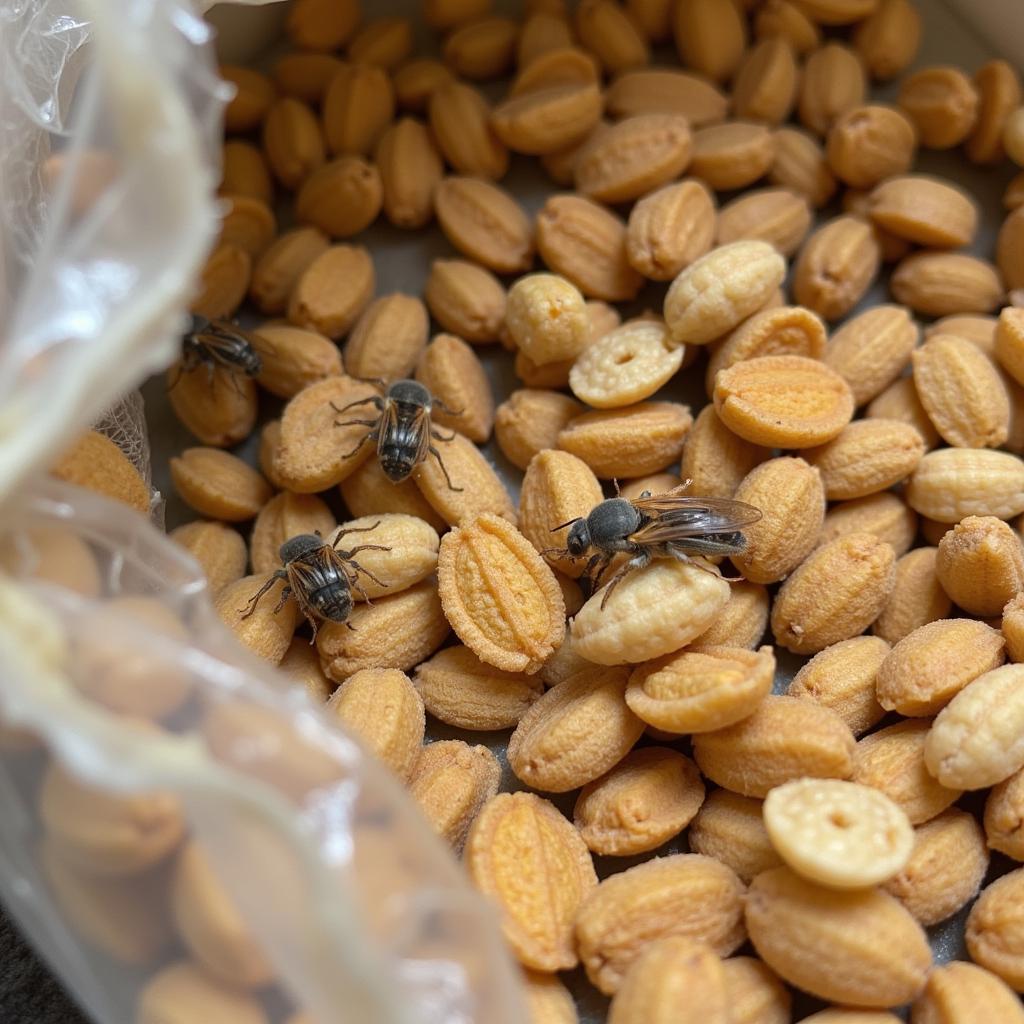Discovering moths in your dog’s food is unsettling. It signals a potential infestation that compromises food quality and your pet’s health. This comprehensive guide will explore why moths target dog food, the risks involved, and effective prevention and elimination strategies.
 Moths Infested Dog Food
Moths Infested Dog Food
Understanding the Culprit: Pantry Moths
The most common culprit behind infested dog food is the Indian meal moth, also known as the pantry moth. These small, grayish-brown moths are attracted to dry pet food due to its abundance of grains, cereals, and other pantry staples. Adult moths lay eggs in the food, and the larvae (small, worm-like creatures) hatch and begin feeding, contaminating the kibble with their webbing, droppings, and shed skin.
Have you ever noticed small, silken threads or clumps in your pantry moths in dog food? These are telltale signs of a pantry moth infestation.
The Risks of Moths in Dog Food
While not directly toxic, consuming moth-infested dog food can pose health risks to your canine companion. The larvae can cause gastrointestinal upset, including vomiting and diarrhea. Furthermore, the presence of moths indicates a compromised food storage environment, potentially leading to mold growth and other contaminants that could harm your pet.
Preventing Moth Infestations
Prevention is key when it comes to pantry moths. Here are some practical tips to safeguard your pet’s food:
- Proper Storage: Store dog food in airtight containers made of plastic or glass. Avoid storing opened bags in cardboard boxes, as they offer little protection against moths.
- First In, First Out: Practice FIFO (First In, First Out) inventory management. Use older bags of dog food before opening new ones to minimize the risk of infestation.
- Regular Cleaning: Clean your pet food storage area regularly. Wipe down shelves, vacuum crevices, and discard any spilled food promptly.
Eliminating Existing Infestations
If you’ve already discovered moths in your dog food, take swift action. Discard any infested food immediately. Thoroughly clean and vacuum the storage area, paying attention to cracks and crevices where moths and larvae may be hiding. Consider using pantry moth traps to catch any remaining adult moths. You may have wondered about dog food moths and how to deal with them effectively.
What Attracts Moths to Dog Food?
The primary attractant is the abundance of grains and cereals found in many dog food formulas. These ingredients provide a rich food source for moth larvae.
Dr. Emily Carter, DVM, explains, “The nutritional composition of dry dog food, particularly those high in grain content, creates an ideal environment for pantry moths to thrive. Proper storage is crucial in preventing infestations.”
Can Dried Egg Products in Dog Food Attract Moths?
While grains are the primary attractant, other ingredients like dried egg product in dog food can also contribute. These ingredients provide additional protein sources for the larvae.
Is a Claim on Some Food Packaging Related to Moth Infestations?
A claim on some food packaging may refer to the product’s resistance to pests, but it’s important to remember that no packaging is entirely foolproof. Proper storage remains essential.
In conclusion, dealing with Moths In Dog Food requires vigilance and proactive measures. By implementing these preventive and elimination strategies, you can ensure your furry friend enjoys safe and nutritious meals. Remember to regularly inspect your pet’s food and storage areas to catch any potential infestations early on.
FAQ
- How can I tell if my dog food has moths? Look for small webbing, larvae, or adult moths in the food.
- Is it safe to feed my dog moth-infested food? No, discard infested food immediately.
- What should I do if my dog eats moth-infested food? Monitor your dog for any digestive upset and consult your veterinarian if necessary.
- How often should I clean my pet food storage area? Clean it regularly, ideally every few weeks.
- What are the best ways to store dog food? Use airtight containers made of plastic or glass.
- Are there any natural remedies for pantry moths? Some natural remedies include bay leaves and vinegar, but their effectiveness varies.
- Can I reuse the dog food container after an infestation? Yes, but ensure it’s thoroughly washed and dried before refilling.
Do you know about the best food places in Denver, Colorado? Check out this guide to Man v Food Denver for some delicious culinary adventures.
Need more help with pet food storage or dealing with pests? Explore our website for more helpful resources on pet care.
When you need assistance, please contact us. Phone: 02437655121, Email: minacones@gmail.com Or visit us at: 3PGH+8R9, ĐT70A, thôn Trung, Bắc Từ Liêm, Hà Nội, Việt Nam. We have a 24/7 customer service team.